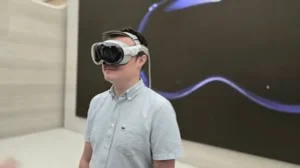The world of design and architecture is rapidly evolving, and a new report by Vectorworks, a leading provider of design software, shines a spotlight on the key trends shaping the industry in 2024. The latest findings explore how artificial intelligence (AI), virtual reality (VR), and sustainability are transforming the way designers, architects, and engineers approach their projects. As technology continues to advance, these innovations are redefining the future of design, with an increasing focus on efficiency, creativity, and environmental impact.
AI: Revolutionizing Design Efficiency and Creativity
Artificial intelligence is making waves in the design world, with its ability to streamline processes and foster creativity. According to the Vectorworks report, AI is increasingly being used to automate repetitive tasks, such as drafting and design iteration, allowing designers to focus on more complex and creative aspects of their work. Machine learning algorithms are also being integrated into design tools to predict optimal solutions and suggest improvements, significantly enhancing the design process.
AI is not only about efficiency but also creativity. Designers can now rely on AI-powered tools that generate design suggestions based on parameters set by the user, opening up new possibilities for innovation. The integration of AI in software is leading to smarter workflows and enabling professionals to work more collaboratively, with the technology adapting to individual preferences and design needs. AI’s growing presence in the design field signals a shift toward more intelligent and adaptive tools that can enhance both productivity and artistic expression.
VR: Immersive Visualization and Collaboration
Virtual reality continues to gain traction as an essential tool in the design and architecture sectors, providing immersive visualization experiences that improve collaboration and decision-making. The Vectorworks report highlights the growing importance of VR for architects and designers, particularly when it comes to presenting concepts to clients and stakeholders.
With VR, designers can create fully immersive environments that allow clients to walk through digital models, offering a deeper understanding of scale, space, and aesthetics. This capability helps identify design flaws early in the process and facilitates more effective feedback. The ability to “experience” a design before it’s built enhances communication between design teams and clients, leading to more informed decisions and reducing costly mistakes during the construction phase.
Moreover, VR technology is fostering collaboration between teams that may be geographically dispersed. Through virtual environments, architects, engineers, and contractors can come together to review designs in real-time, making global collaboration more efficient and effective. The integration of VR into the design workflow is not only improving the design process but also enhancing the user experience for both designers and clients.
Sustainability: Meeting Demands for Green Design
Sustainability remains at the forefront of design trends, with architects and designers increasingly focused on creating eco-friendly, energy-efficient solutions. The Vectorworks report reveals that there is a growing demand for tools that help professionals incorporate sustainable practices into their designs, from energy modeling to material selection.
The report highlights how designers are leveraging software that integrates environmental data, such as weather patterns, energy consumption, and carbon footprints, to make more sustainable design choices. These tools allow professionals to simulate the environmental impact of a design before it is built, helping them reduce waste, optimize energy usage, and select sustainable materials that align with green building standards.
As sustainability becomes a higher priority for clients and communities alike, designers are embracing new technologies to meet these demands. Building Information Modeling (BIM) software, for example, allows for more precise planning and analysis of how a building will interact with its environment. By incorporating sustainability into the core of the design process, architects and designers are playing a critical role in shaping a more environmentally conscious future.
The Future of Design: AI, VR, and Sustainability Working Together
Looking ahead, the report suggests that AI, VR, and sustainability will continue to drive innovation in design and architecture. These trends are not isolated; rather, they are converging to create more intelligent, immersive, and environmentally responsible design processes.
For example, AI-powered tools can analyze environmental data to suggest sustainable design solutions, while VR can provide an immersive experience that allows designers to visualize how these solutions will work in the real world. By combining these technologies, architects and designers are better equipped to meet the challenges of the modern world, from designing energy-efficient buildings to ensuring that their projects are aligned with sustainable development goals.
The Vectorworks report underscores that as the demand for smarter, more sustainable design grows, the adoption of these technologies will only increase. As AI, VR, and sustainability continue to shape the industry, the future of design is likely to be more collaborative, innovative, and environmentally conscious than ever before.
Conclusion
The Vectorworks report offers a glimpse into the future of design, where AI, VR, and sustainability are not just trends, but essential tools that are reshaping how architects and designers work. With AI streamlining workflows, VR enhancing collaboration and visualization, and sustainability driving greener, more energy-efficient designs, the report highlights how the integration of these technologies is transforming the design landscape. As these trends continue to evolve, the architecture and design industries will undoubtedly see even more groundbreaking innovations that prioritize both creativity and environmental responsibility.














